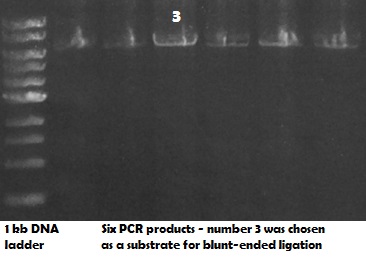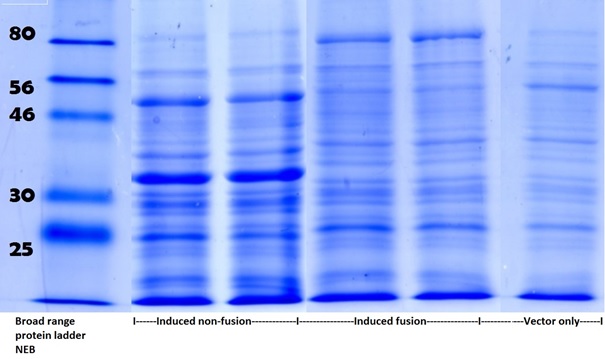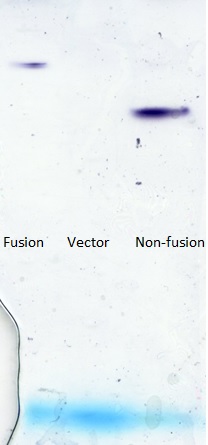Difference between revisions of "Part:BBa K1122673"
(→Protein level evidence) |
(→Protein level evidence) |
||
| Line 42: | Line 42: | ||
| − | In order to express fused pdc-adhB the construct was placed under the control of J33207 – IPTG inducible promoter combined with LacZ reporter. This process generated [https://parts.igem.org/Part:BBa_K1122674] | + | In order to express fused pdc-adhB the construct was placed under the control of J33207 – IPTG inducible promoter combined with LacZ reporter. This process generated BBa_K1122674 [https://parts.igem.org/Part:BBa_K1122674] |
Full grown cultures expressing pdc-adhB fusion and non-fusion were lysed and analysed on SDS-PAGE: | Full grown cultures expressing pdc-adhB fusion and non-fusion were lysed and analysed on SDS-PAGE: | ||
Revision as of 14:09, 3 October 2013
Ethanol production module
This part codes for the fusion of Pyruvate decarboxylase and Alcohol dehydrogenase from Zymomonas mobilis. Fused enzymes increase ethanol yields and enable its faster production.
Generation of protein fusion
In order to generate fusion of pyruvate decarboxylase (pdc) and alcohol dehydrogense B (adhB) Mutagenesis with Blunt- Ended Ligation (MABEL) was used.
A pair of primers was designed complementary with 3' end of pdc and 5' end of adhB. Figure 1 represents the MABEL process.
Fig1. Represents MABEL process used for generation of fused pdc-adhB construct. Primer sequences used: Forward: GCATCAAGCACCTTTTATATCC; Reverse: CAGCAGTTTATTCACCGGTTTAC. See appendix of the Edinburgh University 2013 iGEM team figure 1 for full details on the part sequence, primer binding sites and deleted region.
Generated PCR product (see Fig 1.) was analysed on an agarose gel (Fig 2.):
Fig 2.Presence of a single PCR product of correct size (app. 6000 bp) on a 0.8% agarose gel. 1kb NEB DNA ladder was used. Several replicates of the reaction were loaded on a gel.
Evidence for presence of protein fusion
DNA level evidence
Primers were designed to amplify the region of fusion (region with deleted RBS). Those primers were used for PCR on fused and non-fused pdc and adhB.
Fig 3. 2.5% agarose gel analysing PCR product created using primers amplifying the region of putative gene fusion. As expected fusion product (first 3 lanes) is smaller than non-fusion (last 3 lanes).
The same set of primers was used for sequencing of pdc-adhB fusion construct. Obtained results indicate that the fused state was present on a DNA level:
File:Bioethanol sequencing.zip Presence of following DNA sequence: GTAAACCGGTGAATAAACTGCTGGCATCAAGCACCTTTTATATCC corresponding to reverse complement of reverse MABEL primer followed by forward MABEL primer sequences indicates that gene fusion was obtained.
Protein level evidence
In order to express fused pdc-adhB the construct was placed under the control of J33207 – IPTG inducible promoter combined with LacZ reporter. This process generated BBa_K1122674 [1]
Full grown cultures expressing pdc-adhB fusion and non-fusion were lysed and analysed on SDS-PAGE:
Fig 4. Scan of SDS-PAGE following Coomassie Brilliant Blue G250 staining. Within induced non-fusion lanes two intense bands are present (with size corresponding to pdc and adhB). Within induced fusion lanes described bands are missing and an additional band of increased size is observed. In vector only lane none of above described bands is present. To see full SDS-PAGE go to Appendix figure 2 on Edinburgh iGEM 2013 wiki
In order to present that functionality of adhB is attributed to a peptide of a different mass in fusion state than in non-fusion state a native PAGE was performed.
Fig 5. Native PAGE stained for AdhB activity. Enzymatic activity can be attributed to a peptide of an increased mass in the fusion state (left) than in non-fusion state (right). The vector only sample was loaded in-between.
Moreover, it was presented that pdc and adhB activity can be attributed to same gel band showing that fusion state was indeed obtained:
Fig 6. Native pages with adhB and pdc staining. Both activities are present in a band just below the well. Due to different acrylamide concentration used the fused protein was unable to migrate into the gel as opposed to PAGE present on figure 5.
Sequence and Features
- 10COMPATIBLE WITH RFC[10]
- 12COMPATIBLE WITH RFC[12]
- 21COMPATIBLE WITH RFC[21]
- 23COMPATIBLE WITH RFC[23]
- 25INCOMPATIBLE WITH RFC[25]Illegal AgeI site found at 501
Illegal AgeI site found at 1707 - 1000COMPATIBLE WITH RFC[1000]






